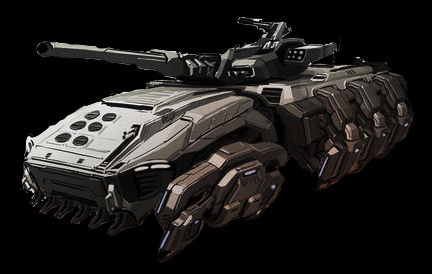Raziel
Dark Jedi Spymaster

Image Source: Unknown. Google images linked deep into a gaming mod site, can’t find game source
Intent: To create a new advanced IFV for the Techno Union
Development Thread: If necessary
Manufacturer: Rothana Heavy Engineering as Prime contractor [Input from Ty'rel Holdings, InnoteQ, Hegemonic]
Model: Acklay IFV
Affiliation: Techno Union
Modularity: Armaments Modular and could be updated
Production: Mass-produced
Material: Durasteel, Quadranium plating
Role: Infantry Fighting Vehicle
Height: 2.4m
Length: 3m
Width: 10m
Weight: 40 tonnes
Minimum Crew: 0
Optimal Crew: 0
Propulsion: Repulsorlift
Top Speed: 70km/h
Armaments: Composite beam laser, heavy repeater, ground to air missiles, grenade launcher
Squadron Count: 12
Passenger Capacity: 16 droids, 1 support unit, 2 humanoids
Cargo Capacity: 2 tonnes of additional munitions, power packs and supplies
Misc. Equipment: Droid launching racks
Description: The Techno Union’s droid armies are typically deployed by low altitude gunships or a troop transport. However, there are times when air superiority is prevented by the enemy, and the MTAT is not suitable for bringing troops right to the heart of battle. For this reason Rothana Heavy Engineering were contracted to provide a new Infantry Fighting Vehicle.
Whilst the vehicle holds all of the droids in compact compartments, its reduced size, and heavy armour mean it cannot hold a full company of troops like the MTAT. Instead each vehicle holds two squads of droids, as well as an additional support unit depending on the use (see below for example loadouts).
Armoured flaps down the side of the vehicle swing open and each cluster of droids (four at a time) are ejected very rapidly. Each droid will unroll, quickly come to its feet, and start engaging the enemy. The droids are hooked up to the vehicle’s sensors during combat, so have instant situational awareness as they exit the vehicle and will immediately engage priority targets. If under fire, the IFV can turn to one side, and eject its full complement out of one side. Otherwise it will open both sides and eject both squads double time. Whilst the droids are thrown out of the vehicle, they can be unloaded in slow time if necessary, by gradually extending racks out of one or both sides. This process is required to re-load the droids. Whilst re-loading both squads of droids takes up to twenty seconds, this risk was considered acceptable given no organics are at risk.
The rear compartment holds one support unit, either a droid mortar, or a Hunter-killer drone. Note that whilst a droid mortar can leave the vehicle and almost immediately deploy, the hunter killer is folded up to fit and will take almost a minute and the assistance of another droid to prepare for launch. The hunter-kill can then provide aerial scouting and close support to the squad, or the droid can provide close fire support.
There is space in the front compartment for two humanoids, similar to where drivers would usually sit. However, the Acklay is designed primary to transport droids. The vehicle has a low profile, as all the droids are rolled up. The humanoids have to sit it reclined seats, with very little space to move. However, several screens are provided to show a view of the battlefield.
InnoteQ were contracted to provide battlefield simulations and come up with the ideal range of armaments for the Acklay. The vehicle is armed with a composite beam cannon. [Equivalent in use to a modern day 20mm autocannon] Whilst less powerful than the weapon of a main battle tank, it nevertheless has the power to directly attack such a vehicle. The rear of the vehicle sports a heavy repeater for engaging infantry. The vehicle houses two small ground-to-air missiles to provide some air defence. Finally, the vehicle has a pod of six grenade launchers that use LIS grenades to provide cover.
The vehicle has a low profile, only 2.4 metres high as droids are folded up, and it hovers very close to the ground. It has quadranium plating to provide excellent protection to its complement of soldiers, as it is designed to bring them directly to combat. Armour is strongest to the front and sides, with reasonable protection on the top and underside. However, mines are liable to knock out repulsors. Armour to the rear is weakest.
The vehicle is controlled by a droid brain. All sensor input is processed immediately, and communications delay between gunner, commander and pilot are completely removed. The vessel uses both a K-65 Targeting system and J-2 Droid Brain with a backup J-1 Droid Brain in case of damage to the primary controller.
This vehicle truly represents a range of top of the line technologies produced by a range of Techno Union corporations.
Typical complements:
Urban:
2x squads
8 Clankers:
8 Clankers:
- 1xPistol and Energy Shield
- 1xScattergun
- 6xCC13 Blaster Rifle
- 4xFlashbang Grenade Carriers
- 2xThermal Detonator Carriers
- 2xLIS Grenade Carriers
Typical Terrain:
2x squads
6 Clankers:
Droid Support Platform with Mortar
or
Hunter Killer Drone
6 Clankers:
- 5xCC13 Blaster Rifle
- 1xReaver Repeater
- 4xConcussion Anti-Armor Grenade Carriers
- 2xThermal Detonator Carriers
- 2xLIS Grenade Carriers
Droid Support Platform with Mortar
or
Hunter Killer Drone
Peace Keeping:
2x squads
8 Clankers:
8 Clankers:
- 4xCC13 Blaster Rifle
- 4xPistol and Energy Shield
- 6xSonic Grenade Carriers
- 2xLIS Grenade Carriers








